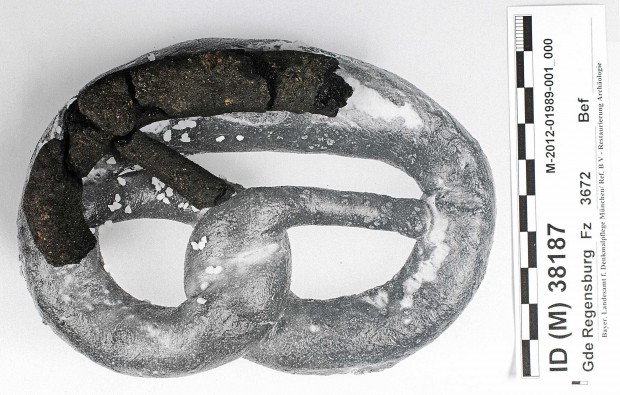Pic shows: One of the remains discovered by German archaeologists.
German archaeologists are hailing as a sensation the discovery of three bread rolls, two pretzels and the part remains of a type of ancient croissant estimated to be at least 250-years-old.
The team made the discovery while working on an excavation site that used to be a former bakery in the eastern Bavarian city of Regensburg where they found the remains of a wooden house thought to be around 1200-years-old.
They initially found more usual discarded household items, but they have now also discovered the bread products that only survived because the cook had burnt them before throwing them away.
And carbon dating has confirmed that they are around 250-years-old when the bakery was owned by local man Johann Georg Held, according to the archives.
Expert Mathias Pfeil, who is responsible for historical monuments in Bavaria, said: « I can really imagine how it was when the Baker Mister Held had realised he had burnt the lot, and in a temper had thrown the whole lot away, not realising what a fascinating insight it would give us 250-years-later into how things were in the past. »
Bavarian Bureau for the Conservation of Historic Monuments spokeswoman Silvia Codreanau-Windauer said: « The fact that the items had been burnt meant they were preserved, to be found by us now at least a quarter of a century later. »
The items had been partially crumbled but were painstakingly reconstructed, allowing the exalted archaeologists to discover that they had in front of them an example of what Silvia described as « definitely the oldest pretzel ever found ».
She said: « We speculate that the 18th-century baker must have thrown them away in disappointment. »
The mayor of Regensburg Joachim Wolbergs said they planned to build a museum in the area for the finds as well as other items that had been yielded in the dig saying: « This discovery is really extraordinary, because it depicts a snippet of everyday life. »
The pretzel in particular has been at the heart of southern German baking traditions for centuries, and in Bavaria in particular is often eaten for breakfast alongside Weisswuerst (white sausage) with sweet mustard.
It was designed according to Sylvia as a religious food saying: « The form of the pretzel is supposed to represent the crossed arms of monks. Eventually it ended up as a fasting meal. »
Monks are the symbol for the state capital city of Munich, and different orders and monasteries give their names to many of the state’s most famous beers, from Augustiner to Weihenstephan – which are all commonly enjoyed with a salty pretzel.
(ends)
